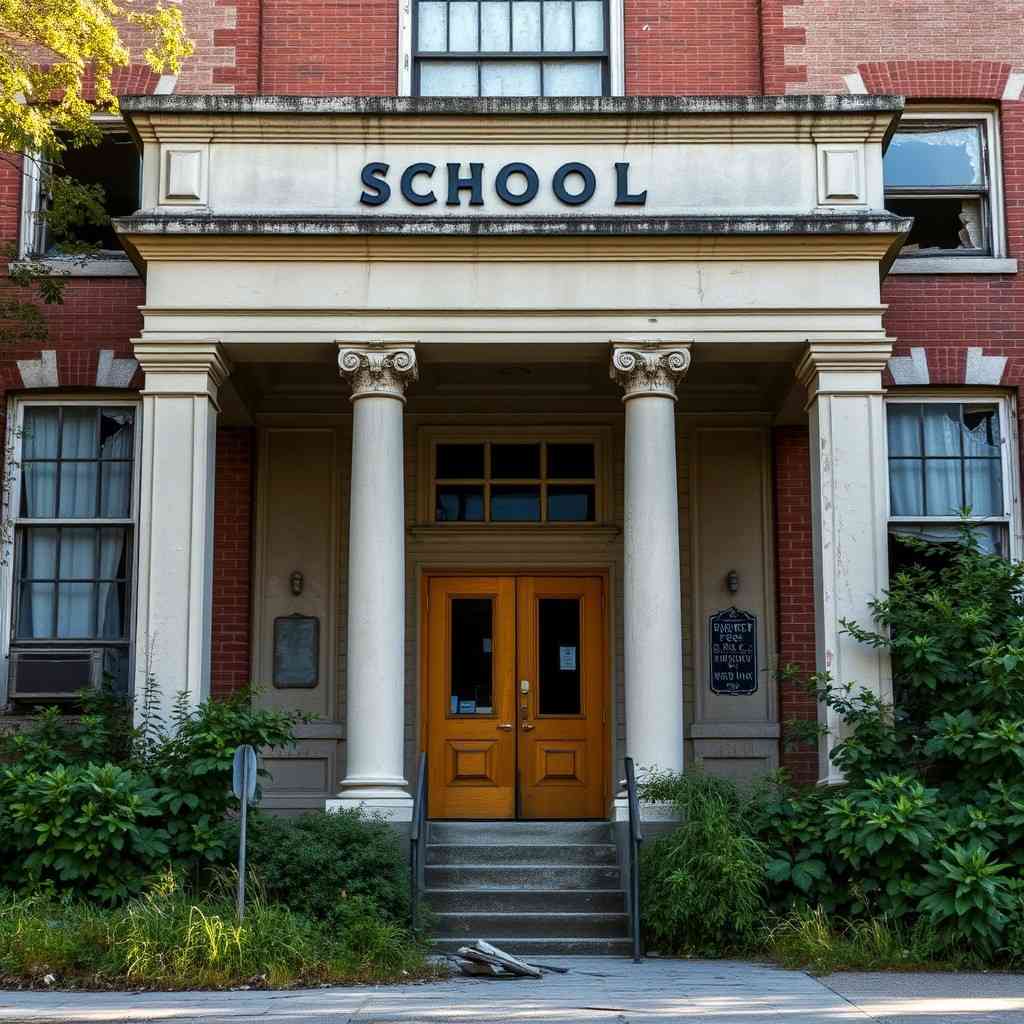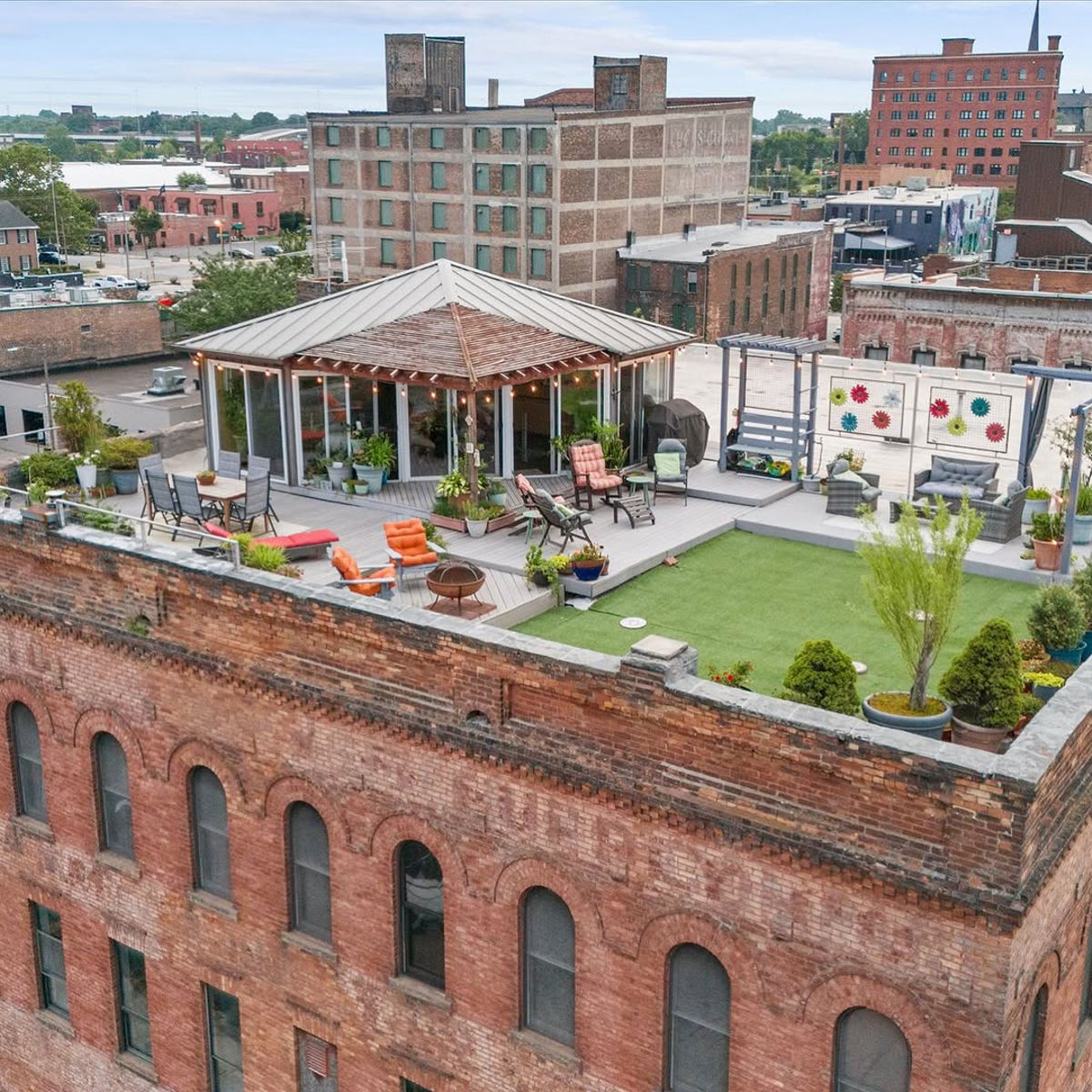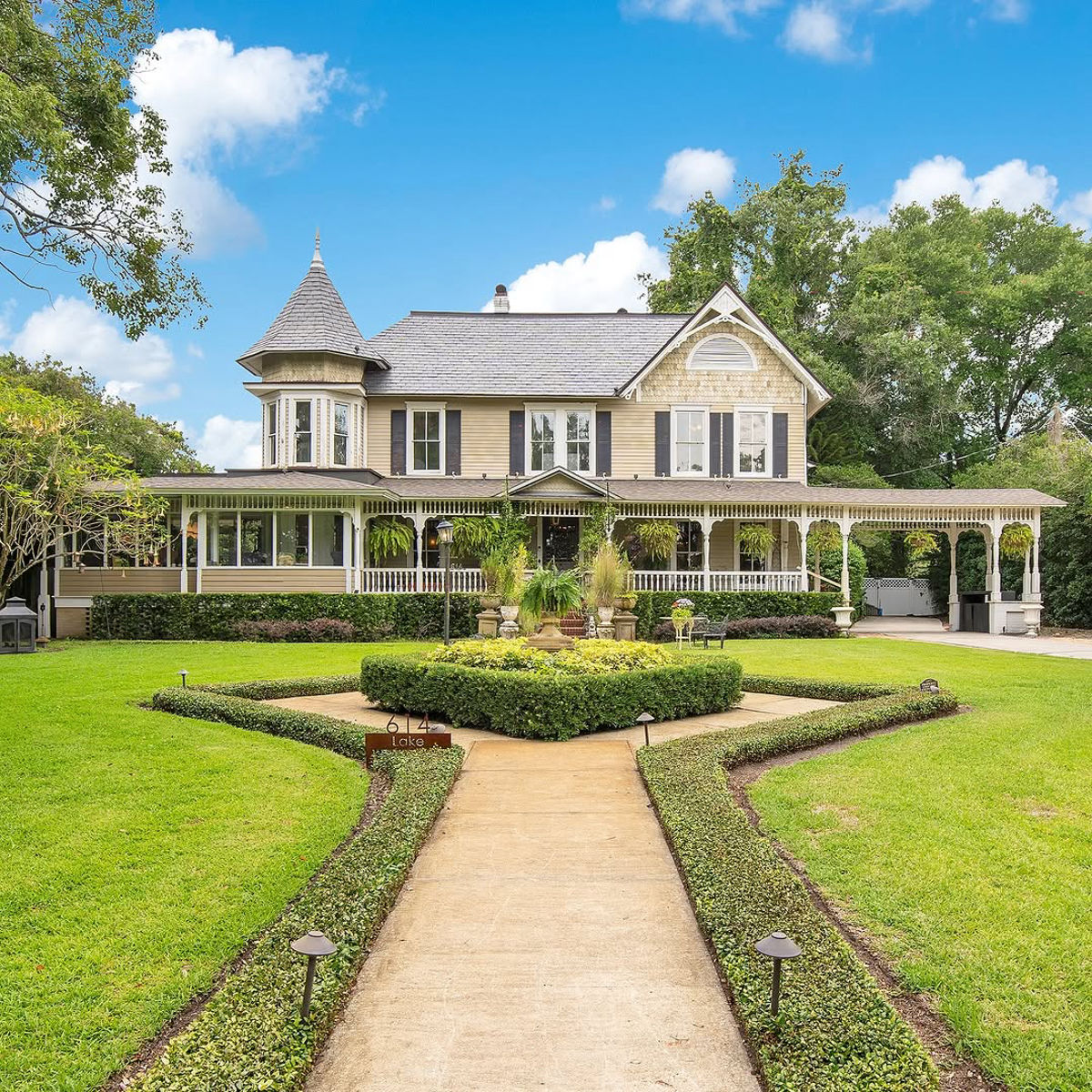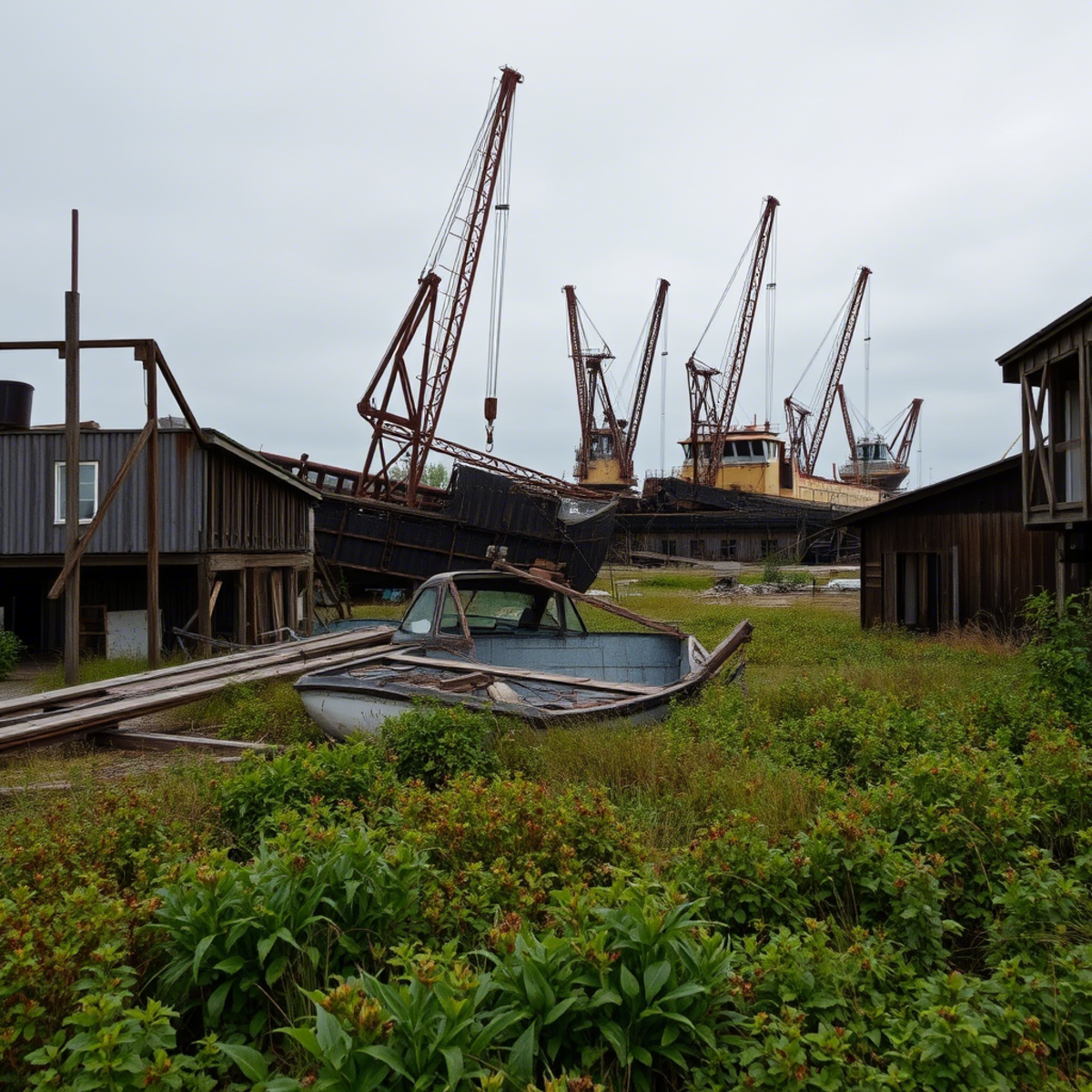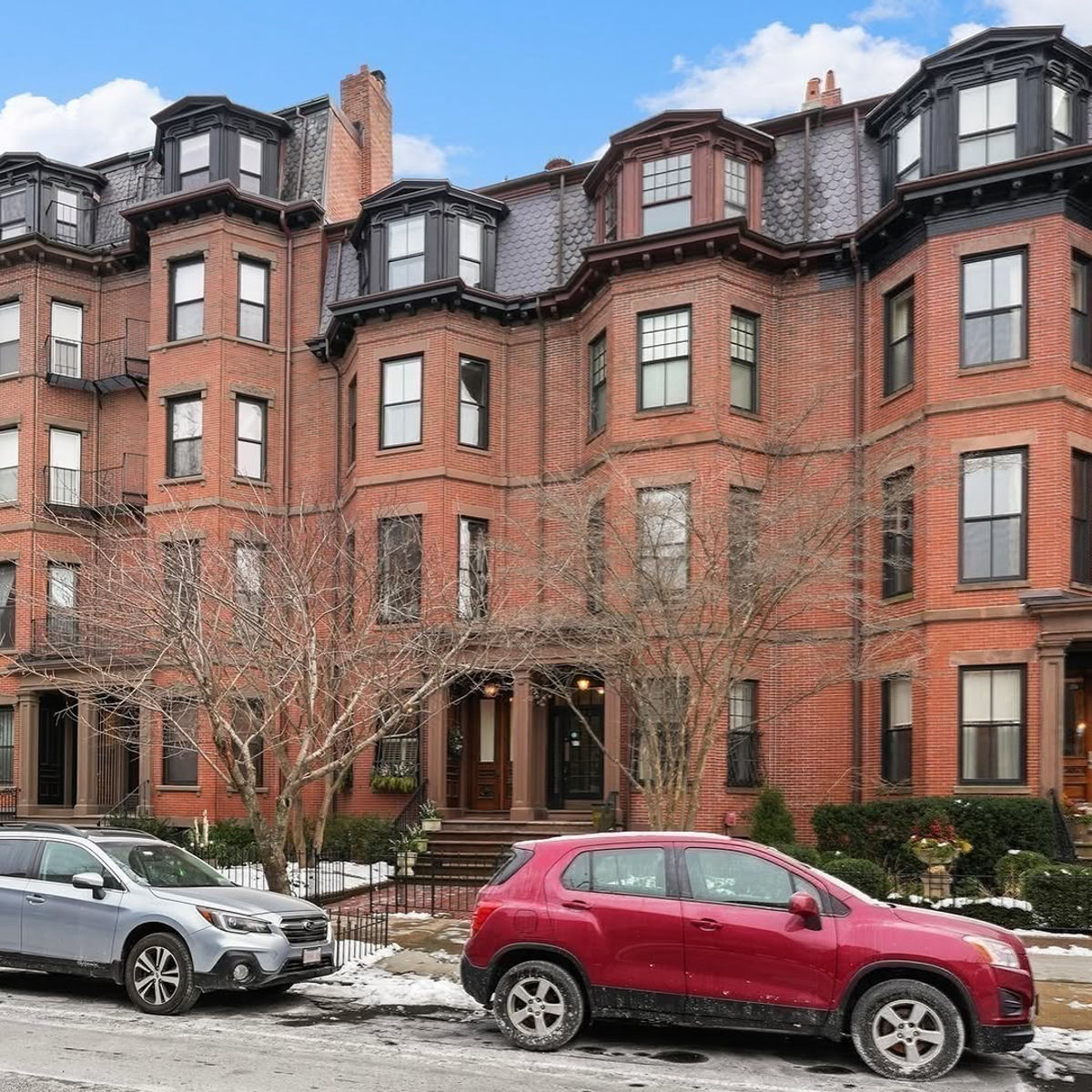Chicago, the Windy City, holds countless stories within its urban landscape. Among the most captivating are the abandoned buildings that dot the cityscape, each telling a tale of bygone eras. One particular structure stands out among urban explorers and history enthusiasts alike: an abandoned school that once buzzed with student activity, complete with a fully equipped auditorium, gymnasium, and swimming pool.
This forgotten educational institution represents more than just empty hallways and silent classrooms. It embodies the rise and fall of Chicago’s educational system, the shifting demographics of neighborhoods, and the economic challenges that have shaped the city’s modern landscape.
A Glimpse into Chicago’s Educational Past
The abandoned school in question represents a time when Chicago invested heavily in comprehensive educational facilities. Built during the mid-20th century, this particular institution was designed to serve as a complete community center, offering not just academic instruction but also cultural and athletic programs that would benefit students and residents alike.
During its operational years, the school served hundreds of students from the surrounding neighborhood. The building’s impressive architecture and comprehensive facilities reflected the optimistic vision of mid-century American education, where schools were conceived as pillars of community life and social development.
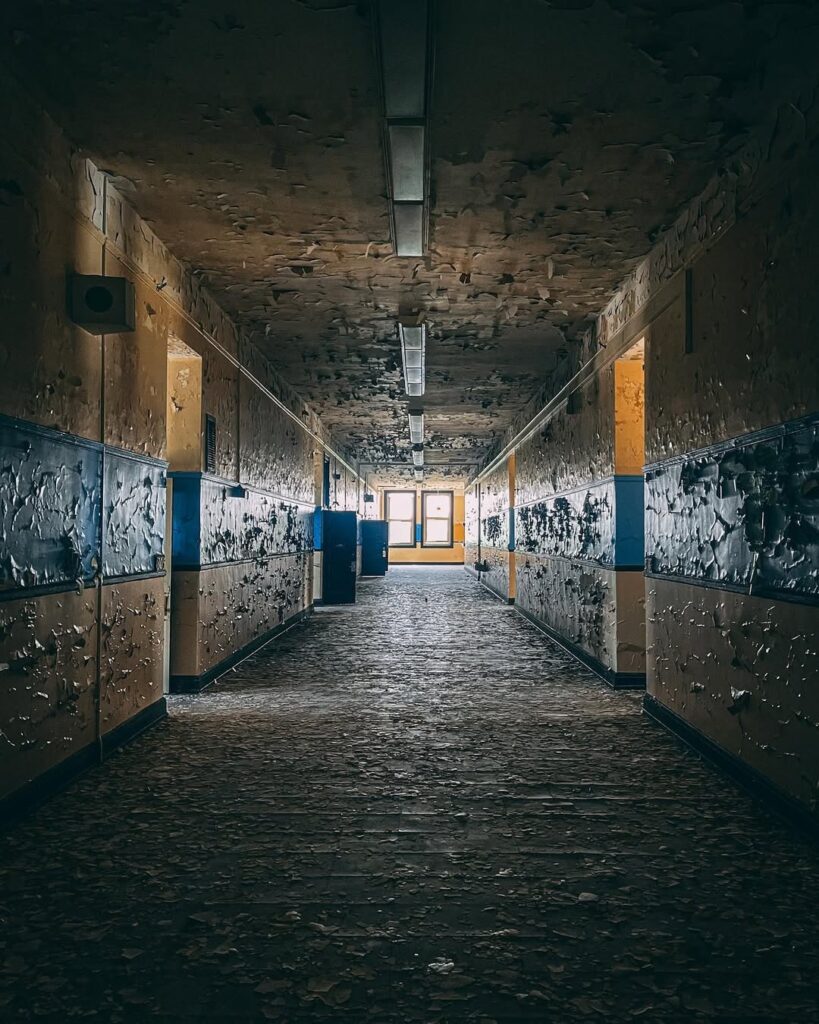

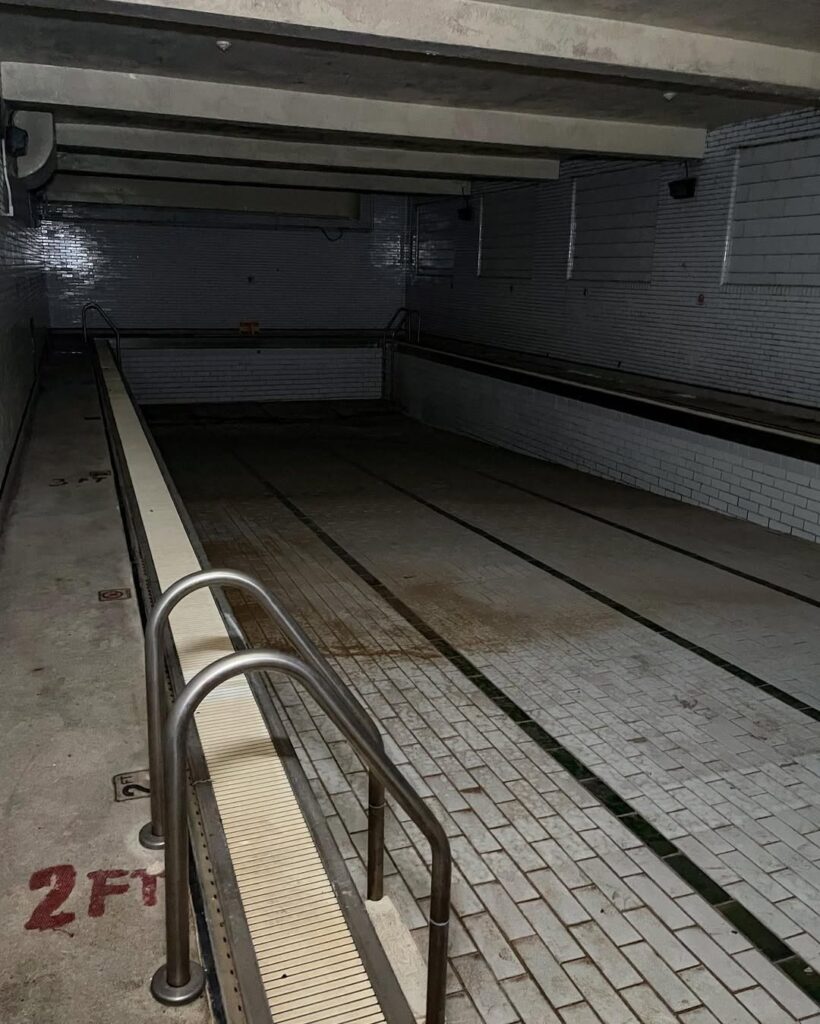
The three-story brick structure spans several city blocks, with wings dedicated to different educational and recreational purposes. The main academic building housed traditional classrooms, science laboratories, a library, and administrative offices. Connected to this central hub were the specialized facilities that made this school truly exceptional: a professional-grade auditorium, a full-sized gymnasium, and an Olympic-length swimming pool.
The Magnificent Auditorium: A Stage Frozen in Time
The school’s auditorium remains one of its most striking features, even in abandonment. With seating for over 800 people, this performance space was designed to rival professional theaters. The stage, complete with a fly system for backdrops and professional lighting equipment, hosted countless school productions, community events, and cultural performances.
Red velvet seats, though now faded and worn, still maintain their dignified arrangement in curved rows facing the proscenium arch. The ornate ceiling features hand-painted murals depicting classical scenes of learning and achievement, a testament to the craftsmanship of an era when public buildings were constructed with artistic vision and community pride.
Behind the stage, dressing rooms with vintage mirrors and costume storage areas remain largely intact. The orchestra pit, designed to accommodate a full ensemble, sits silent beneath the stage’s front edge. Even in its current state of decay, visitors can easily imagine the excitement of opening nights and graduation ceremonies that once filled this space with life and celebration.
The auditorium’s acoustics, carefully engineered during its construction, continue to impress urban explorers who venture inside. A whisper from the stage can be heard clearly in the back rows, demonstrating the sophisticated design principles that went into creating this educational and cultural venue.
The Athletic Heart: Exploring the Gymnasium
Adjacent to the main academic building, the school’s gymnasium stands as a monument to the importance of physical education in mid-century American schooling. The full-sized basketball court, with its polished hardwood floors now dulled by years of neglect, once echoed with the sounds of squeaking sneakers and cheering crowds.
Retractable bleachers line both sides of the court, capable of seating the entire student body for pep rallies and championship games. The school’s mascot and team colors are still visible on the gymnasium walls, painted murals that have survived decades of abandonment. Trophy cases, their glass clouded with age, stand empty near the main entrance, having been cleared when the school closed.
The gymnasium also features a raised running track that circles the main floor, allowing students to exercise year-round regardless of Chicago’s harsh winters. Locker rooms with rows of metal lockers remain largely intact, though many doors hang open, creating an eerie reminder of the students who once changed for physical education classes.
Equipment storage rooms still contain remnants of the school’s athletic program: volleyball nets, gymnastics mats, and basketball hoops in various states of repair. The coach’s office, with its strategic view of the entire gymnasium floor, contains vintage training equipment and faded team photos that speak to the pride and tradition of the school’s athletic programs.
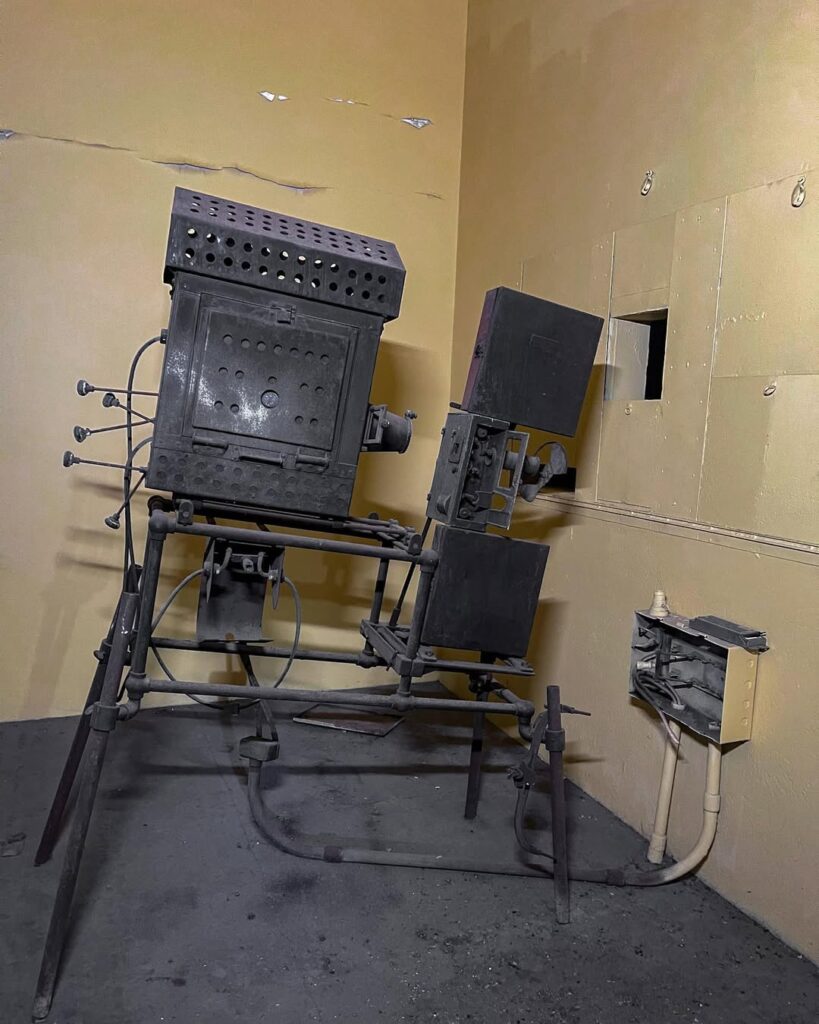
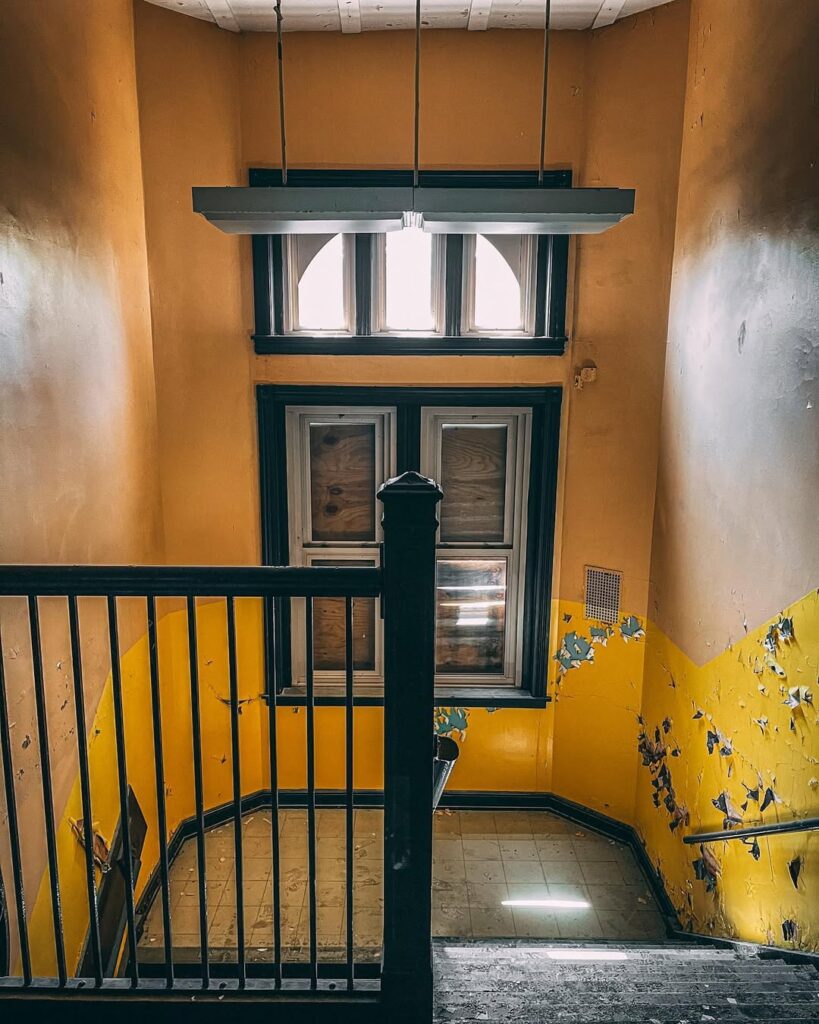
Diving into History: The Abandoned Swimming Pool
Perhaps the most remarkable feature of this abandoned school is its swimming pool, a facility that was considered luxurious even when the school was operational. The Olympic-length pool, measuring 50 meters, was designed to serve both educational and competitive purposes. Swimming classes were mandatory for all students, and the school’s swim team competed at state levels throughout its operational years.
The pool area features high ceilings with large windows that once flooded the space with natural light. Ceramic tiles in the school’s colors create decorative patterns around the pool’s perimeter, while starting blocks remain positioned at one end for competitive events. The diving area, with platforms at various heights, demonstrates the comprehensive nature of the aquatic program.
Surrounding the pool, bleacher seating accommodated spectators for swim meets and water polo games. The pool deck, made of non-slip materials, shows wear patterns where countless students walked from the locker rooms to the water’s edge. Depth markers, painted on the pool’s sides, remain clearly visible despite years of neglect.
The pool’s mechanical systems, including filtration and heating equipment, occupy a separate room accessible through service corridors. These areas provide insight into the sophisticated infrastructure required to maintain such a facility, representing a significant investment in student recreation and health.
The Decline and Abandonment
Like many urban schools across America, this Chicago institution fell victim to changing demographics, budget constraints, and shifting educational priorities. As the surrounding neighborhood experienced economic decline, enrollment dropped significantly throughout the 1980s and 1990s.
Maintenance costs for such an elaborate facility became increasingly difficult to justify with a shrinking student population. The swimming pool, in particular, required constant upkeep and specialized staff that the school district could no longer afford. Similarly, the auditorium’s professional-grade equipment demanded regular maintenance and technical expertise that exceeded the available budget.
The final closure came in the early 2000s, when the Chicago Public Schools system made the difficult decision to consolidate several underenrolled schools. Students were transferred to newer facilities, and the building was officially decommissioned from educational use.
Since closure, various proposals for the building’s reuse have been considered, including conversion to condominiums, community centers, or mixed-use developments. However, the extensive renovations required to bring the building up to modern codes, combined with the significant investment needed, have deterred most developers.
Current State and Urban Exploration
Today, the abandoned school attracts urban explorers, photographers, and history enthusiasts from across the Chicago area and beyond. The building’s relatively intact state makes it a popular destination for those interested in abandoned places and architectural photography.
Security measures have been implemented to prevent unauthorized access, though the building’s size and multiple entry points make complete prevention challenging. Graffiti artists have left their mark in various areas, though much of the building remains remarkably preserved compared to other abandoned structures in the city.
The passage of time has created unique photographic opportunities throughout the building. Natural light filtering through broken windows creates dramatic effects in the auditorium and gymnasium. The empty swimming pool, with its preserved tile work and diving platforms, offers particularly striking visual compositions.
Weather and time have taken their toll on certain areas of the building. Water damage from roof leaks has affected some classrooms and corridors, while the pool area shows signs of humidity-related deterioration. Despite these challenges, the building’s solid construction has prevented complete decay.
Architectural Significance and Design Elements
The school’s architecture represents the mid-century modern movement in public building design, characterized by clean lines, functional layouts, and integration of indoor and outdoor spaces. The building’s design philosophy emphasized natural light, open spaces, and the connection between different educational activities.
Terrazzo floors throughout the main corridors have survived decades of use and abandonment, their speckled patterns and school colors still visible. Stainless steel fixtures, built-in lockers, and institutional-grade materials reflect the era’s emphasis on durability and functionality.
The building’s heating and ventilation systems, though now inactive, demonstrate the advanced engineering that went into creating comfortable learning environments. Large windows in most classrooms were designed to provide optimal lighting for reading and study, while the overall layout facilitated efficient movement between classes.
Art installations throughout the building, including murals, mosaics, and sculptural elements, show the integration of creative expression into the educational environment. These decorative features, created by students and local artists during the school’s operational years, add cultural value to the architectural significance.
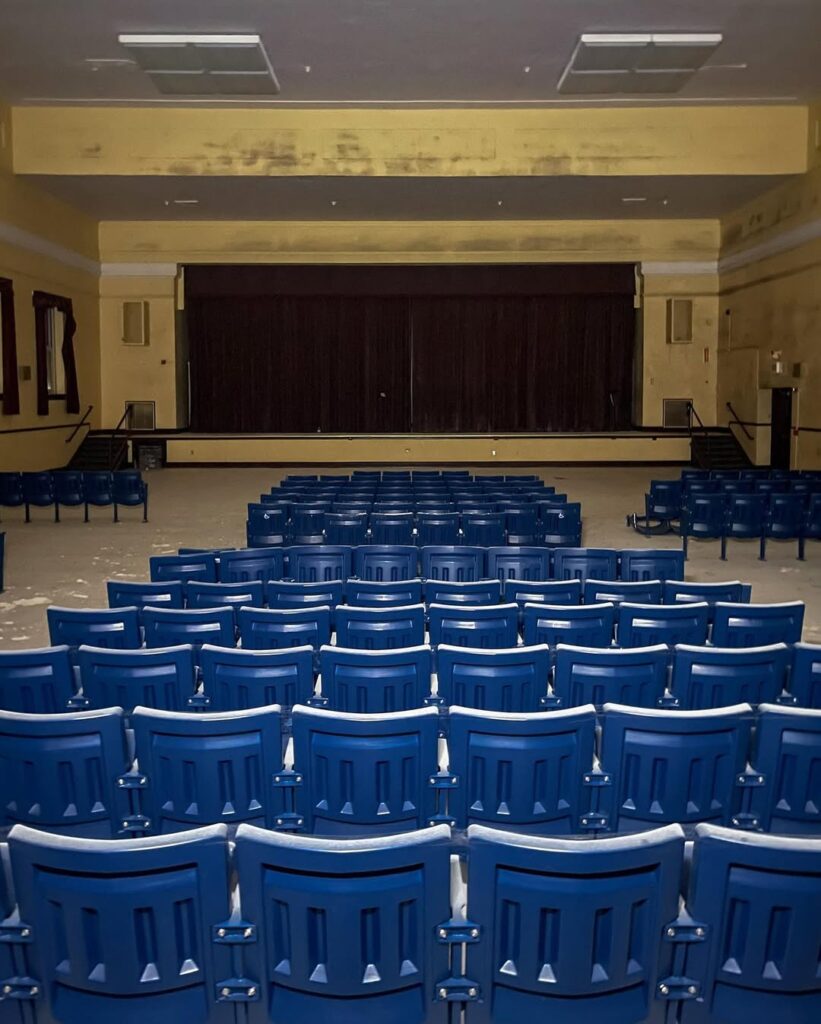

The Broader Context of School Abandonment in Chicago
This particular abandoned school is part of a larger pattern of educational facility changes throughout Chicago. Economic factors, population shifts, and evolving educational philosophies have led to the closure of numerous schools across the city, each with its own story and community impact.
The phenomenon of school abandonment reflects broader urban challenges including deindustrialization, demographic changes, and municipal budget constraints. For communities that lose their schools, the impact extends beyond education to affect neighborhood identity, property values, and social cohesion.
Some abandoned Chicago schools have found new life through adaptive reuse projects, conversion to housing, or repurposing as community centers. These successful transformations provide models for what might be possible with other abandoned educational facilities, including the school with the auditorium, gym, and pool.
Photography and Documentation Efforts
The visual appeal of this abandoned school has made it a subject of extensive photographic documentation. Professional photographers, artists, and urban exploration enthusiasts have captured thousands of images that preserve the building’s current state and document its ongoing deterioration.
These photographic records serve important historical purposes, creating a visual archive of mid-century educational architecture and design. The images also capture the poignant beauty of abandoned spaces, where nature and time slowly reclaim human-made environments.
Social media platforms have increased awareness of the school’s existence, with hashtags and location tags drawing attention from wider audiences. This increased visibility has both positive and negative effects, bringing appreciation for the building’s architectural value while also potentially increasing unauthorized access and vandalism.
Safety Considerations and Legal Issues
Exploring abandoned buildings carries inherent risks, and this school is no exception. Structural concerns, broken glass, unstable floors, and potential exposure to hazardous materials make unauthorized entry dangerous for unprepared visitors.
Legal issues surrounding abandoned property exploration vary by jurisdiction and specific circumstances. In Chicago, trespassing laws apply to abandoned buildings, and violators can face fines, arrest, and criminal charges. Property owners and security companies actively monitor many abandoned sites.
For those interested in the building’s history and architecture, legal alternatives include guided tours (when available), public meetings about the building’s future, and examination of historical records and photographs that document the school’s operational years.
Community Memory and Cultural Impact
Former students, teachers, and community members maintain strong emotional connections to the abandoned school. Reunion groups and social media communities share memories, photographs from the school’s active years, and updates about the building’s current condition.
These personal connections highlight the school’s role as more than just an educational facility; it served as a community gathering place where generations of families attended events, graduations, and performances. The auditorium hosted community theater productions, the gymnasium served as a voting location, and the pool offered recreation for neighborhood residents.
Local historical societies and community organizations work to preserve both the physical building and the memories associated with it. Oral history projects collect stories from former students and staff, creating a record of the school’s impact on individual lives and community development.
Future Possibilities and Redevelopment Potential
Despite its current abandoned state, the school represents significant redevelopment potential due to its size, location, and unique features. The auditorium could be restored as a community performing arts center, the gymnasium could serve recreational purposes, and the pool could provide aquatic programs for the surrounding area.
Adaptive reuse projects for similar buildings in other cities provide models for potential development. Mixed-use conversions that combine residential, commercial, and community spaces have successfully brought new life to abandoned schools while preserving their architectural character.
Funding for such projects often requires creative partnerships between public agencies, private developers, and community organizations. Historic preservation incentives, community development grants, and tax increment financing are among the tools that could support redevelopment efforts.
Frequently Asked Questions (FAQs)
What happened to the abandoned school in Chicago with the auditorium, gym, and pool?
The school closed in the early 2000s due to declining enrollment, budget constraints, and the high cost of maintaining specialized facilities like the swimming pool and professional auditorium. The Chicago Public Schools system consolidated several underenrolled schools, transferring students to other facilities.
Can you legally visit the abandoned school in Chicago?
No, the building is private property and entering without permission constitutes trespassing under Chicago law. Unauthorized access can result in fines, arrest, and criminal charges. Security measures are in place to prevent entry.
What makes this abandoned school unique compared to others in Chicago?
This particular school stands out due to its comprehensive facilities, including a professional-grade auditorium with 800 seats, a full-sized gymnasium with retractable bleachers, and an Olympic-length swimming pool. These features were exceptional even when the school was operational.
Is the abandoned school building structurally safe?
The building shows signs of deterioration after years of abandonment, including water damage, broken windows, and potential structural issues. Professional assessment would be required to determine current safety conditions, and unauthorized visitors face significant risks.
Are there plans to redevelop the abandoned school?
Various redevelopment proposals have been considered over the years, including conversion to housing, community centers, or mixed-use developments. However, the extensive renovations required and associated costs have prevented implementation of these plans.
What was the school’s original purpose and when was it built?
The school was constructed during the mid-20th century as a comprehensive educational facility designed to serve both students and the broader community. It provided academic instruction alongside cultural and athletic programs through its specialized facilities.
How has urban exploration affected the abandoned school?
Urban explorers have documented the building’s current state through photography and social media, increasing public awareness. However, this attention has also led to security concerns and potential damage from unauthorized visitors.
What architectural style does the abandoned school represent?
The building exemplifies mid-century modern institutional architecture, characterized by functional design, clean lines, extensive use of natural light, and integration of specialized spaces for diverse educational activities.
Are there any similar abandoned schools in Chicago?
Chicago has numerous abandoned educational facilities due to demographic changes and budget constraints. However, few feature the combination of professional auditorium, full gymnasium, and swimming pool that makes this particular school notable.
What role did the school play in the community when it was operational?
Beyond education, the school served as a community hub where the auditorium hosted public events, the gymnasium functioned as a community center and voting location, and the pool provided recreational opportunities for neighborhood residents.
Conclusion
The abandoned school in Chicago with its auditorium, gymnasium, and swimming pool represents more than just empty buildings and silent corridors. It embodies the aspirations of mid-century American education, the challenges of urban development, and the complex relationship between communities and their institutions.
While the building sits empty today, its architectural significance, community memories, and redevelopment potential ensure its continued relevance to Chicago’s urban landscape. Whether through preservation efforts, adaptive reuse, or continued documentation, this abandoned school remains an important part of the city’s educational and cultural heritage.
The story of this abandoned school reflects broader themes of urban change, economic challenge, and community resilience that characterize many American cities. As Chicago continues to evolve, the fate of this remarkable building will depend on the creativity, resources, and commitment of those who recognize its value and potential.
For now, the school stands as a monument to the past and a question mark for the future, its empty auditorium, silent gymnasium, and dry swimming pool waiting for the next chapter in their story. In a city known for its architectural treasures and urban renewal projects, this abandoned school represents both the challenges and opportunities that define modern Chicago.
![]()
